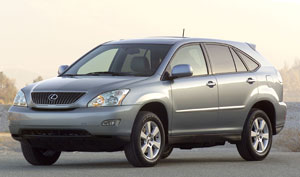 Toyota Motor Sales announced it will conduct a voluntary Safety Recall for a brake problem that occurs once the vehicle has been serviced with non-factory fill/genuine brake fluid.
Toyota Motor Sales announced it will conduct a voluntary Safety Recall for a brake problem that occurs once the vehicle has been serviced with non-factory fill/genuine brake fluid.
The recall involves the following models and affects 740,000 vehicles sold in the U.S.:
• 2005-2006 Avalon;
• 2004-2006 Highlander (non Hybrid);
• Lexus RX330, and
• 2006 Lexus GS300, IS250 and IS350.
Drivers may experience a small amount of the brake fluid leaking from the brake master cylinder, resulting in illumination of the brake warning lamp. If the brake warning lamp has illuminated and the vehicle continues to be operated without refilling the master cylinder brake fluid reservoir, the driver will begin to notice a spongy or soft brake pedal feel and braking performance may gradually decline.
The cause of the leak was cited as non factory-fill Toyota brake fluid added during service of the systems. Toyota claims that some replacement brake fluids do not contain the correct levels of a certain polymer to protect the internal rubber seal (brake master cylinder cup) located at the end of the brake master cylinder piston from drying out and curling during movements of the brake pedal.
The press release states: “The Toyota genuine brake fluid used during vehicle assembly for vehicles sold in the U.S. contains polymers. The polymers act as lubricants for certain brake system components.”
The updated seal is manufactured of a material that can operate in an environment with lower levels of this polymer. This should prevent any further leaks no matter what brand of brake fluid is used to service the system.
In Toyota service information and in owner’s manuals, Toyota specifies SAE J1703 or FMVSS No.116 DOT3 brake fluid. These recommendations are still in place and it is acceptable to use any brand of brake fluid as long as it meets SAE or DOT recommendations.
These standards focus on the boiling point and compressibility, but they also focus on the seal compatibility, corrosion resistance and lubricating properties. But, every brake fluid manufacturer has its own additive package. The unnamed polymer is typically a component.
Owners of the involved vehicles will be notified by first class mail beginning in early November 2010. Toyota and Lexus dealers will replace the brake master cylinder cup with a newly designed one at no charge to the vehicle owners.
Toyota FJ Cruiser Water Pump Replacement
Toyota’s original Land Cruiser was the company’s version of a Jeep that could go anywhere. In its time it was highly rated and collected, which led the Japanese juggernaut to bring back an updated SUV in 2007 called the FJ Cruiser. The retro-styled vehicle was again a go anywhere machine powered by a 4.0L V6 (1GR-FE) used in the Tacoma. The engines are durable and considered relatively robust for the time.
Toyota’s original Land Cruiser was the company’s version of a Jeep that could go anywhere. In its time it was highly rated and collected, which led the Japanese juggernaut to bring back an updated SUV in 2007 called the FJ Cruiser. The retro-styled vehicle was again a go anywhere machine powered by a 4.0L V6 (1GR-FE) used in the Tacoma. The engines are durable and considered relatively robust for the time.
Long-Life Coolants Explained
Different types of coolants cover a range of applications from diesel to domestic, Asian and European vehicles. Each one is formulated to a specific manufacturer’s specifications to keep their engines at an optimal temperature. But, changes to the old one-size-fits-all formula has led to confusion for consumers and even some technicians.

VIDEO: Engine Efficiency Brings More Hoses
Andrew Markel discusses hoses and the necessity for several of them to route fluids to all parts of the vehicle due to the growing efficiency of engines. Sponsored by Dayco.

Diagnosing Intelligent Cooling Systems
The majority of cooling systems on the roads react to what is happening inside the combustion chamber. After the engine is stressed, the heat causes the thermostat to open. Increases in temperatures will also cause the cooling fans to come on. The heat carried by the coolant is the trigger for operation of the fans and thermostat.

Modern Cooling System Design: It’s Not About Temperature; It’s About Powertrain
Given the advanced state of internal combustion engine technology, some recent cooling system innovations will actually increase engine torque and fuel economy while reducing exhaust emissions. Let me simplify that idea: new cooling system technology will make engines run better and cleaner. So, let’s get on the same page by reviewing some basics.

Other Posts
Why Does Engine Coolant Need Replacement?
Two specifications can be used to justify replacement — the condition of the additive package & the freezing point.

Improving Turbocharger Longevity
It is estimated that by 2022, 50% or more of vehicles sold in the U.S. will have one or more turbochargers under the hood.

Engine Cooling System: Hose Inspection and Replacement
One bad hose can cause an engine malfunction. This video is sponsored by Continental.

VIDEO: Power Steering Systems That You Might Encounter
There are three types of power-steering systems today. This video is sponsored by The Group Training Academy.






